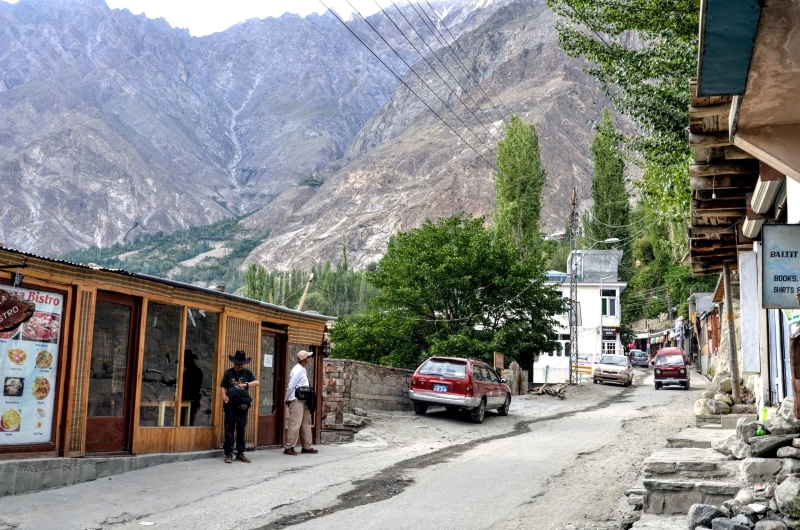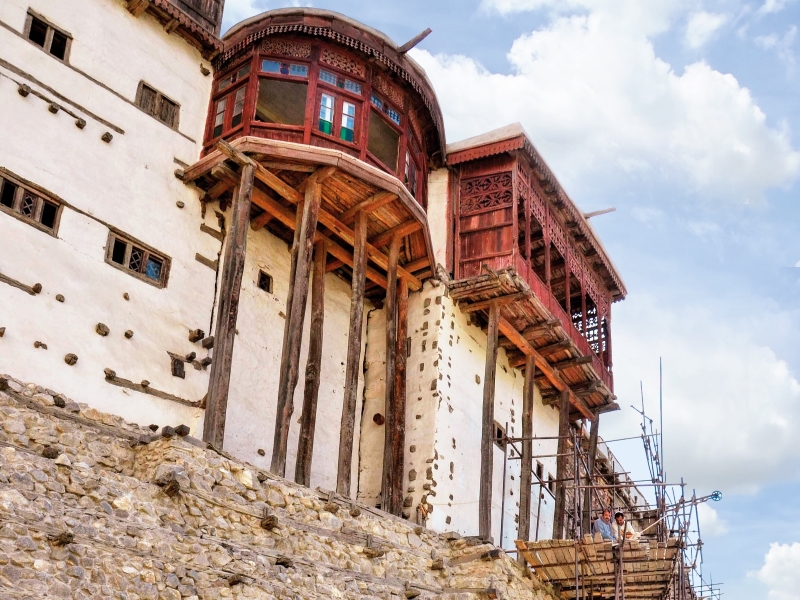
Hikers complete a hike from Karimabad to Duikar (All photos: Lee Yu Kit)
We drove for three days from Islamabad on the Karakoram Highway, the road that the Pakistanis declare is the Eighth Wonder of the World. It is an engineering triumph, a road wrested from precipitous mountainsides, running from the lowlands of Pakistan through its remote, mountainous provinces to the Chinese border at the Khunjerab Pass, from which it plunges into the wilderness of China’s Xinjiang province.
We drove through desolate country of elemental beauty and vastness, great expanses of pink, grey and brown contrasted with a searing blue sky. Snow-covered mountains pierced the sky. In certain places, the road ran by the milky-grey froth of the ancient Indus River, from which India derives its name.
On the third day, we drove into verdant valleys nestled in the deep cleft of mountains, of bustling villages, cold, mountain streams, bearded men, tea, fruit stalls and colourful marketplaces.
A small road led away from the highway — a winding, narrow, mountainous road clinging to the side of steep cliffs.
The road ended with the panorama of a lush hidden valley. A line of poplar trees framed the valley, with dwellings clustered in villages. Above the trees rose an unbroken line of rugged brown mountains, while behind them was the serrated teeth of snowy mountains, wreathed in clouds.
The mountain ranges dipped to the valley carved by the Hunza River, framing the shimmering, snow-covered summit of 7,788m-tall Mount Rakaposhi.
karimabad.jpg

The Hunza Valley has long possessed an almost mythical grip on the popular imagination. Inhabitants of this hidden valley are said to be one of the longest-lived people in the world, with an average life expectancy exceeding 100 years (although claims of longevity are difficult to substantiate, due to the absence of reliable birth records). It has been speculated to be the inspiration for the mythical Shangri-La in James Hilton’s 1933 novel Lost Horizon, which was published a few years after he visited the valley. It was a stopover on the Old Silk Road, a sliver of independent territory hemmed between the great powers of China and India, until 1891, when it was invaded by the British.
Hunza continued to exist as it always had. Hardy mountain tribes lived as they had for generations, amid dense forests with milky-blue streams, upland meadows and snow-crested mountains. It was not until 1974 that the principality of Hunza was dissolved and absorbed into the Gilgit-Baltistan region, the most northerly territory of Pakistan.
Even in 21st-century Pakistan, the Hunza Valley was a sundered world, ensconced in the bubble wrap of timelessness, shielded from the churn of the everyday world outside.
The people — tall, fair-skinned and sometimes startlingly pale-eyed — were predominantly of the Islamic Ismaili sect, of which the Aga Khan is the spiritual head. Unlikely as it seemed, the population literacy rate was almost 100%.
At the base of the sawtooth mountain range, on a rocky promontory overlooking the valley, sat the ancient looking Baltit Fort, the traditional residence of the Mirs of Hunza, who ruled over this mountain enclave for almost 1,000 years.
The capital of Hunza, formerly known as Baltit, was called Karimabad. The main road was a narrow, paved track lined by small shops selling local produce: fresh and dried fruits, honey, nuts, a few souvenir shops, restaurants, a bakery, and the services of a small town with provisions, hardware, vehicle repair and a marketplace.
bread.jpg

At a “kindness” wall, clothing and shoes could be donated. Opposite, the first-floor Café De Hunza served its famous walnut-honey cake, freshly brewed coffee and a view of the mountains.
Small restaurants, including Hidden Paradise restaurant, served local cuisine, such as dowdo soups, characterised by the addition of freshly made, thick noodles to boiling broth.
One morning, I hiked up the steep path leading away from the main street, up a cobbled alley lined by shops, past the football pitch that had once been one of the world’s highest polo grounds, and into the shadow of Baltit Fort. A branch led steeply up to the dangerous path to the Ultar glacier, and Ultar peak, attempted many times, yet never successfully scaled. The water from the glacier fell in a series of steep, narrow gorges into Karimabad. The water was a metallic grey, glistening in swirling patterns from finely-ground mica, which the locals called “water flowers”.
From a distance, Baltit Fort looked small against its towering mountain backdrop. Up close, it was colossal, presenting high walls in front, with the living area at the topmost tier. It was a museum, having been donated by the Mir of Hunza to a trust and restored by funds from the Aga Khan foundation in the 20th century.
The Tibetan-influenced architecture was obvious. A staircase led to the entrance at the back, into a series of small and cosy chambers. The reception area had coloured glass windows, a British influence added in the 20th century, while Chinese and Persian currency and ancient Russian firearms hung on the walls. A hanging balcony added in recent times provided a view of the town far below.
The palace kitchen with its utensils, the freezer room for storing food in winter, wine cellars, granary and secret room for meetings provided glimpses of royal life. On the sun-drenched roof, the skull of a rare Marco Polo sheep and ibex decorated one of the terraces, from which there was a spectacular view of the valley.
baltitwall.jpg

Baltit Fort was seven centuries old, but the oldest monumental structure in the valley was the 1,100-year-old Altit Fort, situated below in the village of Altit, a short drive from Karimabad. Originally the residence of the Mirs of Hunza until they shifted to Baltit Fort some three centuries later, Altit Fort was continuously occupied until the mid-20th century.
Altit Fort was smaller and less imposing, with the entrance doorway at 90 degrees to the stairs to foil battering ram charges. The rooms were smaller, with thick walls that moderated the temperature within. Wooden panels were elaborately carved with recognisably Tibetan motifs.
From the roof was a stunning view of the Karakoram Highway far below with the milky-blue Hunza River running beside it. The flat-topped roof led to the narrow dead-end execution point, where prisoners were flung over the edge to certain death in the precipitous depths below.
The watchtower was the oldest part of the fort, but there was a village nearby even older, believed to be the oldest and first settlement in the Hunza Valley, when it was an important stopover on the ancient Silk Road.
The small nondescript village of Ganish is believed to be some 1,400 years old. The houses of the village were clustered around a large open communal pool. Originally Buddhist, the inhabitants converted to Islam centuries later. Several ancient, small mosques in the village have been recognised by Unesco for their cultural value.
An even earlier, murkier past could be glimpsed as we drove down from Hunza. A little distance away were the Sacred Rocks of Hunza, a cluster of rocks by the road. They bore petroglyphs from the early days of the Silk Road — graffiti from a distant past.
cannon.jpg

Ibex were a common theme, indicating the ubiquity of the animal in the area, and inscriptions in exotic scripts — Tibetan, Karosthi, Gupta, Bactrian, Brahmi, even Sogdian, itself originally derived from Aramaic, evidence of cross-cultural and far-flung influences on the ancient road.
One morning, I struck out from Karimabad with my guide for a hike to the neighbouring valley along the Channel walk, following the path of irrigation channels from the Ultar glacier. We hiked towards Baltit Fort, branching out to a small footpath that led behind the fort. A wooden bridge spanned the rushing stream fed by the Ultar glacier, into upland meadows of poplar trees and brambly vegetation.
The path followed the contour of the mountainside, leading to just below the treeline, and expansive views of the valley below, framed by the ranges of mountains that led the eye towards the distant, snowy outline of Mount Rakaposhi.
The first yellows of autumn were beginning to tinge the leaves of the trees. A few hours later, we came to Duikar, a rocky promontory over the valley and a popular spot from which to watch the sunset.
We had cold drinks in the Eagles’ Nest hotel at Duikar, watching the shadows lengthen across the timeless valley below.
In the novel Lost Horizon, inhabitants of Shangri-La enjoyed perfect health, lived extremely long lives and remained youthful looking. If they left Shangri-La for the outside world, they aged suddenly to their natural age, with the attendant infirmities of old age and disease.
In the Hunza Valley, inhabitants are said to live long, healthy and active lives. Although modern in aspects, they live much as they traditionally have in the divine beauty of the remote, hidden valley, a time capsule of when the world was a simpler, younger and more innocent place.
This article first appeared on Aug 28, 2023 in The Edge Malaysia.


